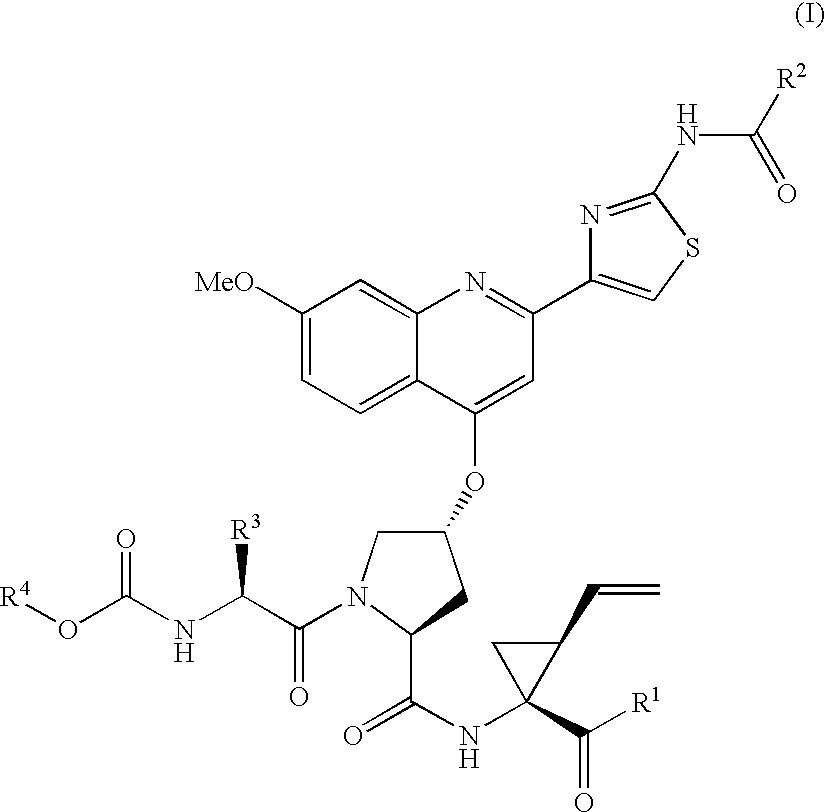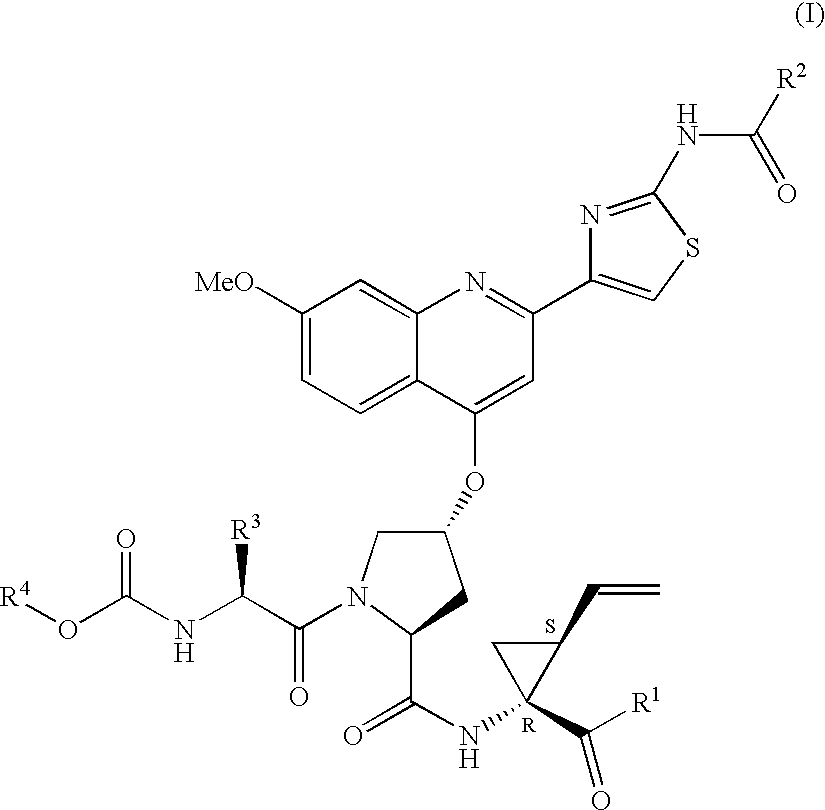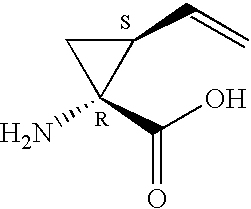Hepatitis C inhibitor tri-peptides
a peptide and hepatitis c technology, applied in the field of compounds, can solve the problems of lack of effective, recommendation of immunoglobulin treatment, and lack of cellular and humoral immune responses to protect against hcv infection and disease, and achieve the effects of not showing significant inhibitory activity, good pharmacokinetic profile, and enhanced stability of the formulation compound or its delivery form
- Summary
- Abstract
- Description
- Claims
- Application Information
AI Technical Summary
Benefits of technology
Problems solved by technology
Method used
Image
Examples
example 1
Synthesis of Compound 100
[0115]
Step 1: Preparation of Intermediate 6a
[0116]Boc-Dipeptide 5a (3.05 g; 4.31 mmol) was dissolved in 4 N HCl / dioxane (22 mL). After stirring at R.T. for 30 min., the HCl salt precipitated. MeOH (2 mL) was added to dissolve the precipitate. After 2 h, the reaction mixture was evaporated to dryness. The resulting HCl salt was dissolved in DCM (22 mL) and DIEA (3.0 mL; 17.24 mmol); carbamate 3a (1.15 g ; 4.47 mmol) and HATU (1.72 g ; 4.516 mmol) were added. The solution was stirred at R.T. for 6 h. The mixture was then diluted with EtOAc and the solution washed with saturated NaHCO3 (2×), water (2×) and brine (1×), dried (MgSO4), filtered and evaporated to obtain compound 6a as a yellow solid. Flash column chromatography eluting first with hexane:EtOAc 7:3 and then 6:4 afforded pure Me-ester 6a as a white foam (3.25 g; 90%). M.S. (electrospray): 831.4 (M−H)− 833.4 (M+H)+ 855.4 (M+Na)+. Reverse Phase HPLC Homogeneity (0.06% TFA; CH3CN:H20): 98%.
Step 2: Hydrol...
example 2
Synthesis of Compound 101
[0123]
[0124]By following the same procedure as described in the first step of example 1, and using Boc-dipeptide 5c instead of 5a, compound 6b was obtained.
[0125]Compound 6b (70 mg, 0.095 mmol) was dissolved in 2 mL of DCM and successively treated with DIEA (0.045 mL, 0.26 mmol) and pivaloyl chloride (0.015 mL, 0.12 mmol). After stirring for 1 h at 40° an additional pivaloyl chloride (0.015 mL, 0.12 mmol) was added and stirring was continued for an additional 2 h. After the solution was concentrated, the residue was dissolved in EtOAc. The solution was washed with a saturated solution of NaHCO3 and brine, dried (MgSO4) and concentrated to afford 82 mg of crude compound 6c which was used without purification.
[0126]Methyl ester derivative 6c was hydrolyzed as in step 2 of example 1 and purified by preparative HPLC using a YMC Combi-Prep. ODS-AQ column, 50×20 mm. ID, S-5micron, 120 A, and a linear gradient program from 2 to 100% AcCN / water (0.06% TFA).
[0127]Fra...
example 3
Preparation of Compound 102
[0131]By following the procedure described in example 1 and using carbamate 3d instead of 3a and using preparative HPLC to purify the final compound as described in example 2, compound 102 was obtained as the trifluoroacetate salt:
[0132]
[0133]1H NMR (400 MHz,DMSO-d6): ca, 90:10 mixture of rotamers, major isomer description; δ12.37 (s, 1H), 8.54 (s, 1H), 8.40–8.06 (m, 2H), 7.67–7.40 (m, 2H), 7.26 (d, J=8.0 Hz, 1H), 7.26–7.13 (m, 1H), 5.77–5.65 (m, 1H), 5.62–5.49 (m, 1H), 5.23–5.16 (m, 1H), 5.10–5.03 (m, 1H), 4.57–4.37 (m, 3H), 4.03–3.88 (m, 2H), 3.94 (s, 3H), 2.64–2.54 (m, 1H), 2.41 (s, 2H), 2.37–2.22 (m, 1H), 2.04–1.95 (m, 1H), 1.79–1.21 (m, 16H), 1.17–0.85 (m, 5H), 1.04 (s, 9H). M.S.(electrospray): 843.5 (M−H)− 845.4 (M+H)+. Reverse Phase HPLC Homogeneity (0.06% TFA; CH3CN:H20): 99%
PUM
| Property | Measurement | Unit |
|---|---|---|
| Temperature | aaaaa | aaaaa |
| Temperature | aaaaa | aaaaa |
| Temperature | aaaaa | aaaaa |
Abstract
Description
Claims
Application Information
 Login to View More
Login to View More - R&D
- Intellectual Property
- Life Sciences
- Materials
- Tech Scout
- Unparalleled Data Quality
- Higher Quality Content
- 60% Fewer Hallucinations
Browse by: Latest US Patents, China's latest patents, Technical Efficacy Thesaurus, Application Domain, Technology Topic, Popular Technical Reports.
© 2025 PatSnap. All rights reserved.Legal|Privacy policy|Modern Slavery Act Transparency Statement|Sitemap|About US| Contact US: help@patsnap.com



